Hauptwerk Project 2
This is a project to repurpose a defunct 1983 four manual Makin electronic organ from the Methodist Church in Bishop Auckland, County Durham UK, to a
Hauptwerk
virtual pipe organ.
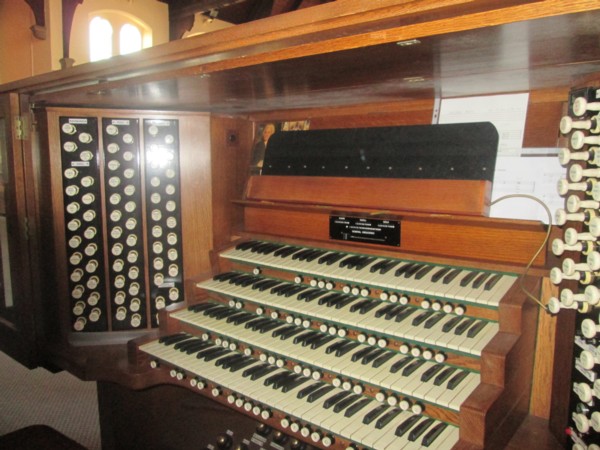
Makin Organs
Makin Organs Ltd. has its roots in the John Compton Organ Company of Acton, West London. Formed in 1902 to build church pipe organs, Compton moved into making cinema
organs in the 1920s and 1930s alongside Wurlitzer and Christie. In the 1950s Compton developed the Electrone
range of electronic organs using their proprietary spinning electrostatic tone-wheels. John Compton died in 1957 and the pipe organ department was sold to Rushworth and Dreaper
in 1964. The remaining electronic department folded in 1970 and was bought by John Pilling, a Lancashire industrialist and organ enthusiast, becaming Makin Organs of Rochdale.
A history of Makin Organs from 1972-1992 has been written by Hugh Banton,
one time engineer and technical director. The Bishop Auckland organ is mentioned on page 24.
The Bishop Auckland Makin Organ
Bishop Auckland had two Methodist churches in close proximity near the town centre. The Primitive Methodist church was completed in 1905 and a
2-manual pipe organ was installed by Binns of Leeds. The Wesleyan church was completed in 1914 and
a 3-manual pipe organ was installed by Vincent of Sunderland.
In 1982 the Vincent organ in the Wesleyan church was damaged beyond repair by a leaking roof, and John Hart, the organist, took the opportunity to replace it with a large electronic
4-manual Makin organ with a stop list copying that of nearby Durham Cathedral, although with a few extra reeds thrown in for good measure. See
here for a stop list comparison of the Henry Willis / Harrison & Harrison organ at Durham Cathedral and
the Bishop Auckland Makin.
In 1993 the Wesleyan and Primitive (now called the Central) churches in Bishop Auckland combined at the
Central site and the Wesleyan building was sold (now the Four Clocks Community Hub). The Makin organ was moved
to the Central church and became the regular service instrument, since the 1905 Binns organ while still playable was not in good condition and in need of attention after nearly 90
years' use. The Binns organ was in fact refurbished in 2014, which was just as well since the Makin blew up with a loud bang during a service in 2017 and was judged to be beyond
economic repair.
The Makin Installation
While smaller electronic organs of the period could be entirely contained within the console, an organ of this size and complexity necessitated not only the loudspeakers but the
power amplifiers and Rotofon units (this organ had two) to be installed outside the console, the rear of one even as big as this being completely filled with the sound generation
circuit boards and the large low voltage power supply for the motorised draw stops. The early 1980s electronics were digital rather than 1970s analogue but predated the use of
microprocessors.
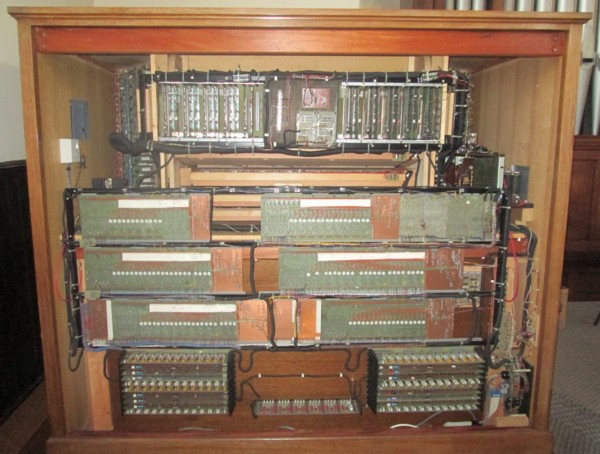
Located near the console were enclosed loudspeakers and the Rotofon units (originally developed by Compton in the 1960s), all mounted in the Binns organ chamber
directly behind the display pipes (this Rotofon photo is from another organ), and the bass column, both described in the Makin history. Separately there was a
large speaker cabinet high above the west galley which could be switched in or out from the console.
Here is a difficult to photograph view of the enclosed loudspeakers and one of the Rotofon units, mounted right behind the front pipes
above the Binns console; removal would be quite impossible without dismantling the front pipe rack and/or neighbouring pipe organ
mechanism. The other Rotofon unit is behind the side pipe rack and more accessible.
Mosfet Power Amplifiers
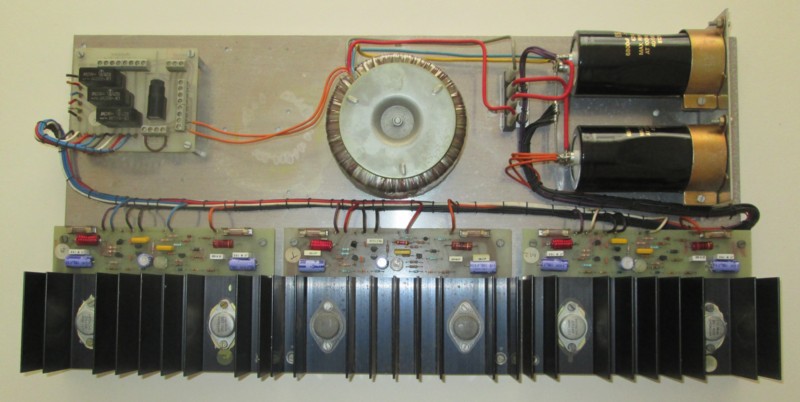
Makin used Mosfet based power amplifiers of their own design, assembled in either three (as in the photo) or five board units. Each unit was independently mains powered from a
nearby wall socket and switched on and off via a relay board (top left) controlled from the console. A 20-way cable conveyed both multi-channel audio and relay control signals.
Mosfet transistors became available in the early 1980s and proved popular in audio amplifier designs (see here and this electronics magazine article), not least because of their ruggedness
in unforgiving environments. The circuit design uses a balanced power supply thus avoiding the need
for a large electrolytic output capacitor.
Keyboards

The four manuals are well made wood cored keyboards from Herrburger
Brooks of Camden, London, not far from Compton in Acton. Founded in 1810 it was the world's oldest established maker of piano actions,
hammer heads, and keyboards; they ceased trading in 1998. They are still in generally good condition apart from some lifting of the white key
coverings, no longer ivory of course, perhaps due to damp over the years. Keyboard scanning is achieved using a pair of 0.35mm diameter silver
plated spring wires for each note, electrically shorted by a silver plated spring end on the note body when a key is depressed.
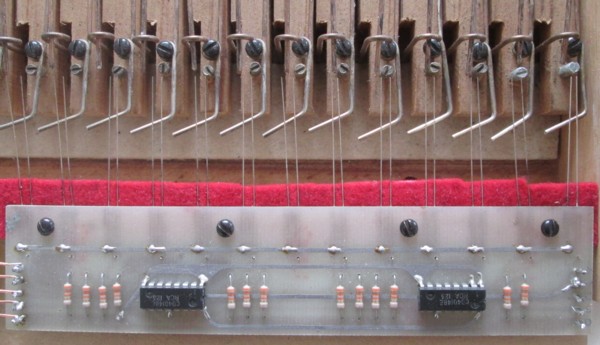
The bright machine screw adjusts the height of the key so that all keys sit at exactly the same level. A slot is cut in the threaded
end of the screw to enable adjustment since the normal slot in the screw head is inaccessible. The black woodscrew provides an
adjustment of the height of the contact and hence the degree of depression at which the key sounds, so that all keys sound with the
same depression.
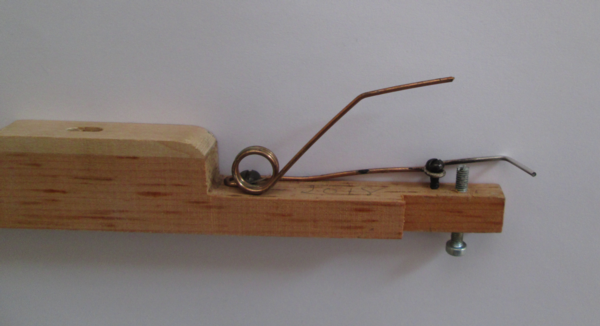
Digital conversion is done by reading the state of all 61 keys together in parallel and then clocking the data out serially using a number of CD4014 CMOS 8-stage static shift registers with
synchronous parallel inputs in series, in effect forming a 61-bit shift register (see circuit).

All the contact silver plating is thoroughly blackened with tarnish after a third of a century, and the scanner boards will need removing from each keyboard, both to clean the
delicate contact wires and give access to the key mounted contact wires.
Thumb Pistons
There are about the same number of thumb pistons as the Durham Cathedral organ console, but laid out and annotated
differently. The majority are double touch, additional pressure engaging a second contact.

The pistons are secured in place with a tiny wood screw hidden under the felt strip. The screw thread grips the side of the plastic piston
barrel.
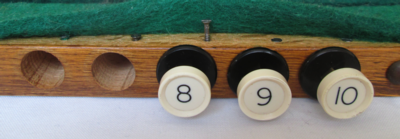
Pedal Board
The pedal board is a conventional 32 note radiating/concave RCO specification. The contacts are open to air silver plated pins mounted on the pedals and sprung wires on the frame,
and like the keyboards they were heavily tarnished. In addition each note uses a very thin braided copper wire to connect the moving pedal pin and handle the repeated pedal movement
without snapping after a short while, and many of these were on the point of going open circuit after several decades - interestingly all in the bottom half of the pedal board,
reflecting the concentration of pedal playing in this region.
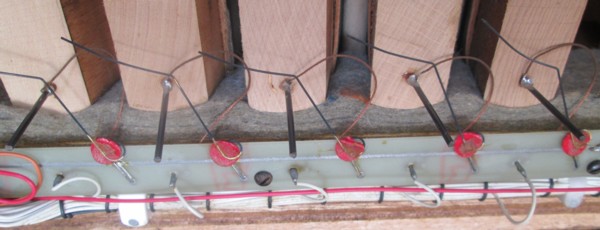
Digital conversion is done in the same way as for the keyboards, reading the state of all 32 keys together and then clocking the data out serially (see
circuit). The photo also shows an Arduino board mounted on the pedal board frame, handling the
MIDI encoding and USB interfacing.
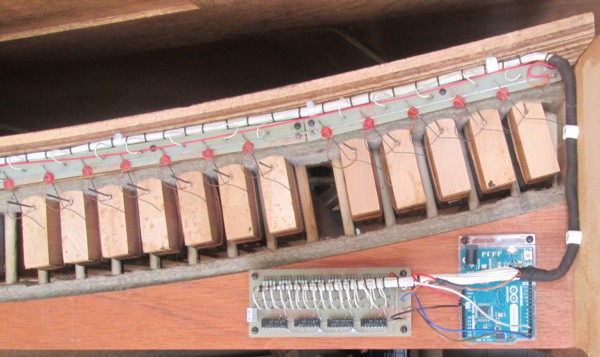
There are about the same number of toe pistons as the Durham Cathedral organ console, but again laid out and annotated differently. Some of them are double touch.
MIDI Conversion
Since keyboard and pedal data is available in serial form these could be entirely MIDI-fied with a single Arduino Uno processor board, there being ample digital I/O and sufficient
processing power to scan the keys at an acceptably fast rate. However given the very low cost of these boards (under £10, $10) it is convenient to use separate Arduinos for each
keyboard and the pedal board, keeping wiring to a minimum and allowing digital input and reserve processing capacity to handle contact debouncing and thumb/toe piston inputs.
Sample code for keyboards and pedal board is given below - this will be refined in due course. Contacts are scanned twice with a gap of several milliseconds and both sets of
keystate data compared in order to achieve reliable debounce of contacts subject to silver tarnish over time.
Keyboard Code
Pedal board Code
The draw stops could be similarly digitally encoded using Arduino boards and the diode matrix scanning method more commonly used on keyboards - there are sufficient digital I/O
pins on two Arduinos to scan all the draw stops. The analogue inputs on an Arduino could encode the four swell pedals. Note that excluding the ability to drive the motorised draw
stops the entire console could be MIDI-fied and interfaced to a computer entirely powered by the computer USB ports, with no mains power required to the console itself.
Update December 2019
It would have been quite straightforward to clean up the organ components and wire up the cosole for Hauptwerk, and that could have been done
by now. However there is no sample set for Durham Cathedral, and the limited number of four manual organs (e.g. Salisbury and Hereford
Cathedral in the UK and a small number of continental organs) have far fewer stops than Durham Cathedral. They are also quite expensive - one
sample set plus the full (Advanced) Hauptwerk license would cost over £1,000.
My plan over the winter months is to write my own organ emulation software from scratch in Microsoft Visual Basic, using the Windows Audio
Session API (WASAPI) to achieve unlimited
polyphony. As well as costing nothing this will enable full computer control of every aspect of the console hardware, something that is
impossible to achieve with commercial packages like Hauptwerk. For example it would no longer be necessary to be tied to the slow 1970s-era
MIDI interface, which has severe limitations with today's hardware. In due course I will make the software available as an open source project.
Update Spring 2023
Well, Covid and the resulting chip shortage pretty much knocked this project on the head, but I am now picking it up again. Watch this space.....
The 1982 Makin organ at Lancaster Priory
The history and fate of a similar size (120 drawstops, 99 speaking stops) and age (1982) Makin organ may be of interest.
The Anglican Parish Church of St. Mary (Lancaster Priory) had a largely
new Harrison & Harrison organ installed in 1922, although much was only prepared for. Harrison & Harrison returned to
complete the build in 1965. This in turn was replaced in 1979 by an
electronic organ, to free up the space taken up by the organ chamber for a new meeting room and kitchen. Since the Makin definitely dates from 1982
there was presumably an earlier electronic organ in use for a period.
By 2009 the "notorious Makin electronic" was
increasingly unreliable with difficult or impossible to rectify faults. However it remained in use until 2012 when David Wells of Liverpool
installed two redundant pipe organs, a 1915 Willis in the west
gallery and a smaller 1904 Harrison & Harrison in the north chancel, both playable from a single console.
An attempt was made to find a good home for the Makin, and an
online blog commencing August 2011 documents progress with lots of interesting comments (be sure to click through all three pages). In
summary the Makin was dismantled and taken to Rishworth School near Halifax by James Kenny, the music master. However Makin themselves said
that it would be a mammoth task to reassemble the organ, and in a final post in 2018 James noted that the school had been unable to provide the
funds to restore the Makin and had offered it to him. He engaged
Nottingham MIDI Organs in early 2018 to construct a Hauptwerk organ out of the console components; since the original console was en-fenetre
this involved building new sides and rear to make a free standing console.
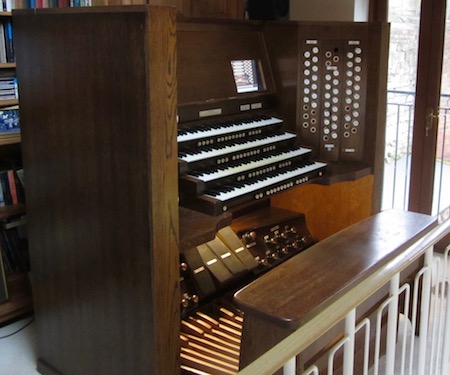
The organ was listed on eBay for £20,000 in November 2019. There were no bidders. The listing notes that the stop knobs have not
been re-engraved to match the purchased Hauptwerk organ (in this case Hereford Cathedral, which in any case has only 67 speaking stops); this
is always a difficulty when reusing an old console, and especially so when more than one Hauptwerk sample organ is available. It also notes a
problem with the seat height adjusting mechanism, exactly as on the Bishop Auckland seat - the mechanism is frankly flimsey and inadequate in
design.
The Original Makin Organ Specification
GREAT
Double Diapason 16'
Bourdon 16'
Large Diapason 8'
Small Diapason 8'
Rohr Gedekt 8'
Quint 5,1/3
Octave 4'
Principal 4'
Gedeckt 4'
Twelfth 2 2/3
Principal 2'
Super Octave 2'
Blockflote 2'
Tierce 1 3/5
Cymbale III
Foumiture IV
Plein Jeu VII
Double Trumpet 16'
Trumpet 8'
Octave Trumpet 4'
SWELL
Quintadena 16'
Open Diapason 8'
Gedeckt 8'
Salicional 8'
Vox Angelica 8'
Principal 4'
Flute 4'
Super Octave 2'
Larigot 1 1/3
Sesquialtera II
Mixture III
Mixture V
Double Trumpet 16'
Trumpet 8'
Trompette 8'
Oboe 8'
Vox Humana 8'
Clarion 4'
|
CHOIR
Quintaton 16'
Stopped Diapason 8'
Quintaton 8'
Zauber Flote 8'
Unda Maris 8'
Viole 8'
Principal 4'
Koppel Flute 4'
Nazard 2 2/3
Fifteenth 2'
Spitz Flute 2'
Tierce 1 3/5
Larigot 1 1/3
Sifflote 1'
None 8/9
Mixture III
Cymbale III
Scharf IV
SOLO
Contra Viole 16'
Hohl Flute 8'
Viole 8'
Viole Celestes 8'
Hohl Flute 4'
Octave Viole 4'
Hohl Flute 2'
Cornet des Violes III
Dulcian 16'
Post Horn 8'
Orchestral Trumpet 8'
French Horn 8'
Cor Anglais 8'
Corno di Bassetto 8'
Cromorne 8'
UNENCLOSED
Tromba Real 8'
Tuba Magna 8'
Grand Chorus Bass 16'
Grand Chorus VII
|
PEDAL
Double Open Wood 32'
Open Wood 16'
Principal 16'
Violone 16'
Sub Bass 16'
Dulciana 16'
Octave 8'
Cello 8'
Spitz Flute 8'
Fifteenth 4'
Octave Spitz Flute 4'
Septieme 2 2/7
Super Octave 2'
Hohl Flute 2'
Mixture IV
Sharp Mixture III
ENCLOSED
Contra Bombarde 32'
Ophiclelde 16'
Bassoon 16'
Trumpet 8'
Oboe 8'
Clarion 4'
Schalmel 4'
Kornet 2'
(Solo expression pedal)
|
The Original Makin Console and Circuit Board Racks